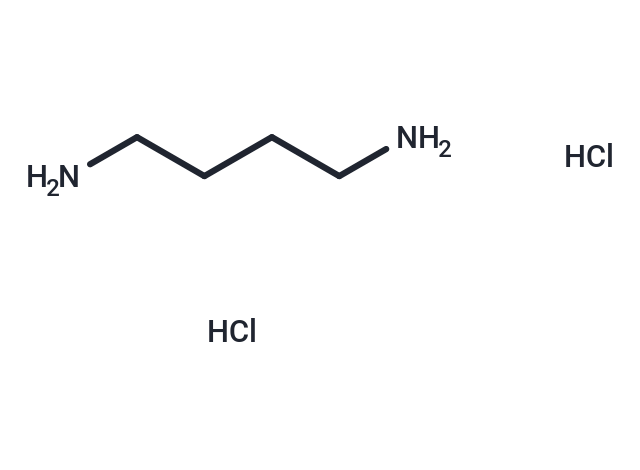Shopping Cart
- Remove All
 Your shopping cart is currently empty
Your shopping cart is currently empty

1,4-Diaminobutane Dihydrochloride (1,4-butanediamine Dihydrochloride) has antidepressant and analgesic effects. It regulates plant defense against environmental stresses by directly killing fungi and inducing resistance mechanisms, enhancing post-harvest mango fruit resistance to Colletotrichum gloeosporioides.

| Pack Size | Price | Availability | Quantity |
|---|---|---|---|
| 100 mg | $30 | In Stock | |
| 500 mg | $62 | In Stock | |
| 1 g | $89 | In Stock | |
| 1 mL x 10 mM (in DMSO) | $39 | In Stock |
| Description | 1,4-Diaminobutane Dihydrochloride (1,4-butanediamine Dihydrochloride) has antidepressant and analgesic effects. It regulates plant defense against environmental stresses by directly killing fungi and inducing resistance mechanisms, enhancing post-harvest mango fruit resistance to Colletotrichum gloeosporioides. |
| In vitro | 1,4-Diaminobutane Dihydrochloride (100-1000 μM, 24 h) stimulated the growth of CT-26 tumor cells. [1] 1,4-Diaminobutane Dihydrochloride (33.2 mmol/L, 24h) disrupted epithelial compact junction (TJ) integrity in isolated mouse colon tissue. [2] 1,4-Diaminobutane Dihydrochloride (0.25-1 mmol/L) significantly reduced bacterial growth in a concentration-dependent manner. |
| In vivo | Administration of 1, 4-diaminobutane Dihydrochloride in mice exacerbated colon inflammation and increased intestinal permeability. [2] 1,4-Diaminobutane Dihydrochloride (1% concentration added to drinking water) reduces EcNC101 colonization and tumor development in AOM/DSS mouse models of colorectal cancer. [3] |
| Alias | 1,4-butanediamine Dihydrochloride |
| Molecular Weight | 161.07 |
| Formula | C4H14Cl2N2 |
| Cas No. | 333-93-7 |
| Smiles | NCCCCN.Cl.Cl |
| Relative Density. | 1.2524 g/cm3 (Estimated) |
| Storage | Powder: -20°C for 3 years | In solvent: -80°C for 1 year | Shipping with blue ice. | ||||||||||||||||||||||||||||||||||||||||
| Solubility Information | DMSO: 5 mg/mL (31.04 mM), Sonication is recommended. H2O: 40 mg/mL (248.34 mM), Sonication is recommended. | ||||||||||||||||||||||||||||||||||||||||
Solution Preparation Table | |||||||||||||||||||||||||||||||||||||||||
DMSO/H2O
H2O
| |||||||||||||||||||||||||||||||||||||||||

Copyright © 2015-2025 TargetMol Chemicals Inc. All Rights Reserved.